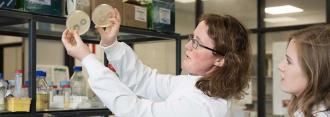Stemming the tide of antibiotic resistance
ToggleExploring mechanisms to prevent resistance moving into disease-causing organisms

This spectre of a post-antibiotic world moved closer with recent news that bugs in China could shrug off a drug-of-last-resort (colistin). The resistance was discovered in E. coli bacteria in pigs and in patients; this is worrying, yet how resistance gets into bacteria is often mysterious. It a question that Dr Fiona Walsh in Maynooth University grapples with in her research; she also works on preventing this from happening.
Understanding how resistance develops
“You may imagine antibiotics as something scientists invented and that resistance is payback from bacteria. In fact antibiotics and resistance is as natural as bacteria,” says Dr Walsh. “The medicines we use mainly come from soil bacteria and fungi. They are naturally produced compounds,” she explains, “though we change them to make them more effective.”
Tens of thousands of bacterial strains can live in a handful of soil and they will use their own chemicals to do battle amongst themselves. Scientists have lifted some of these chemicals and used them as antibiotics. Penicillin famously was discovered in a mould. But bacteria do not simply keel over when attacked by other bacteria - they defend themselves.
“Bacteria have naturally evolved ways to resist antibiotics or toxic chemicals,” says Dr Walsh, who studies how, why and when such resistance hops over to harmful bacteria. Some bugs produce enzymes that chop up natural or man-made antibiotics; others use pumps to flush toxins out. Still others tweak parts that antibiotics latch onto so to protect themselves. This matters to patients.
The recipe for these resistance strategies come in two forms, Dr Walsh explains. They can be written in their regular DNA or they can be on circular pieces of DNA called plasmids. These circles of DNA at times easily transfer between some bacteria, and grant protection to regular, harmless bacteria in soil, water or animals.
Impact of wastewater treatment plants
Dr Walsh is concerned with resistance passing to bugs that can cause disease. Part of her research looks for antibiotic resistance genes and plasmids in treatment plants for sewage and water; she is especially interested in antibiotics, resistant bacteria or resistance genes exiting treatment facilities and flowing into our environment.
These are great places for bacteria to learn new tricks. “Lots of bacteria can come together here, along with antibiotics that pass down our loos, drains, and you have pressure on these bacteria to develop resistance,” says Dr Walsh. Millions of bugs and a soup of antibiotics are ideal for playing survival of the fittest, with the winners being hardy, resistant bugs and potentially dangerous.
A project involving many European countries is now looking at what is going into and what is coming out of wastewater treatment plants. “The question is, do they stay in the treatment plant or are they coming out of the plant,” asks Dr Walsh. And although there are regulations and standards for the quality of water that comes out of plants and into our streams, rivers, oceans, there are no standards in terms of antibiotics or bits of DNA or bacteria with antibiotic resistance.
We simply do not know what the regulations should be, or how best to minimise the chances of dangerously resistant bugs flowing out into our waterway, Dr Walsh explains. She is part of the group of scientist across Europe trying to find out if there is a problem and how to improve our treatment facilities. Dr Walsh’s research is being funded by the Environmental Protection Agency.
Patient health
And it all comes back to patient health. “If antibiotics don’t work, the bacteria will win and cause damage or even kill the patient. What we need to do is make sure as little antibiotic resistance gets into disease-causing organisms as possible,” Dr Walsh explains.
A disease-causing bug able to resist one antibiotic is bad, but those causing most concern are resistant to multiple drugs and therefore most difficult to kill. “It always comes back to the clinic. Anything we can find that contains resistance to 2 or 3 antibiotics would be of most concern,” says Dr Walsh. “We need to know where this resistance comes from and how it gets into the pathogens.”
Using DNA to study populations of bacteria
The issue of antibiotic resistance in our wastewater treatment plans, in our waterways and even in our food chains was, until recently, really challenging for scientists to get to grips with. Scientists simply cannot grow all the bugs that they might find in water or soil; the easiest are the disease-causing bacteria because they tend to like lots of nutrients and temperatures similar to that in our bodies. Other bugs never grow on the petri dishes you find in labs.
Dr Walsh can now use DNA to study the entire population of bacteria in a spoonful of water or soil due to scientific advances. “It is only recently that we can look at all the DNA in a single soil sample for a relatively small amount of money. Twenty years ago we simply could not do that. Ten years ago it was too expensive.”
Late last year, a report warned that there could be hundreds of millions of premature deaths and $100 trillion lost to the world economy by 2050 due to antibiotic resistance. The research of Dr Walsh and her colleagues around Europe is trying to discover how to spot risks and stymy resistance moving into harmful bacteria in people or animals.
One way to minimise the emergence of more antimicrobial resistance will be to maximise the ability of our wastewater treatment plants to stop its spread. This would save lives.
